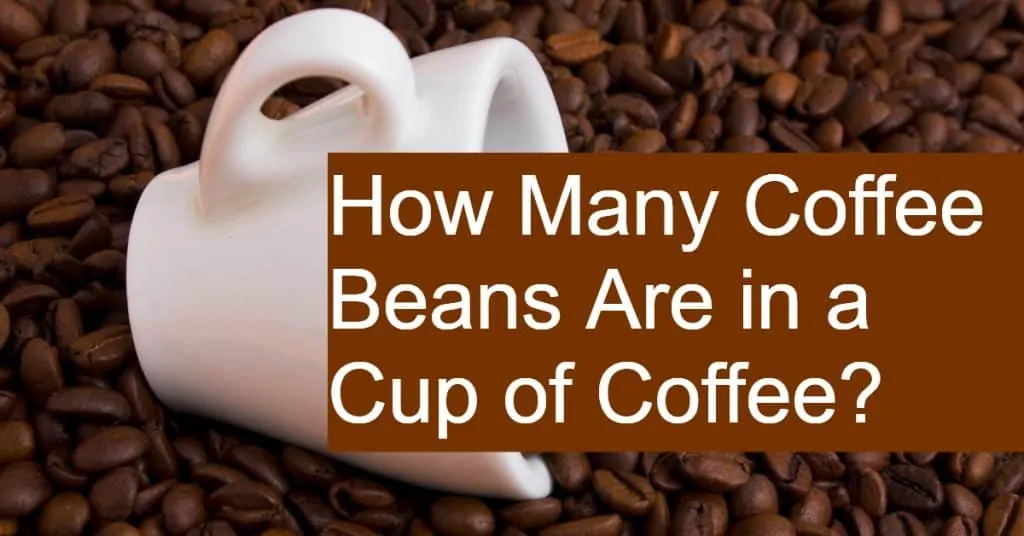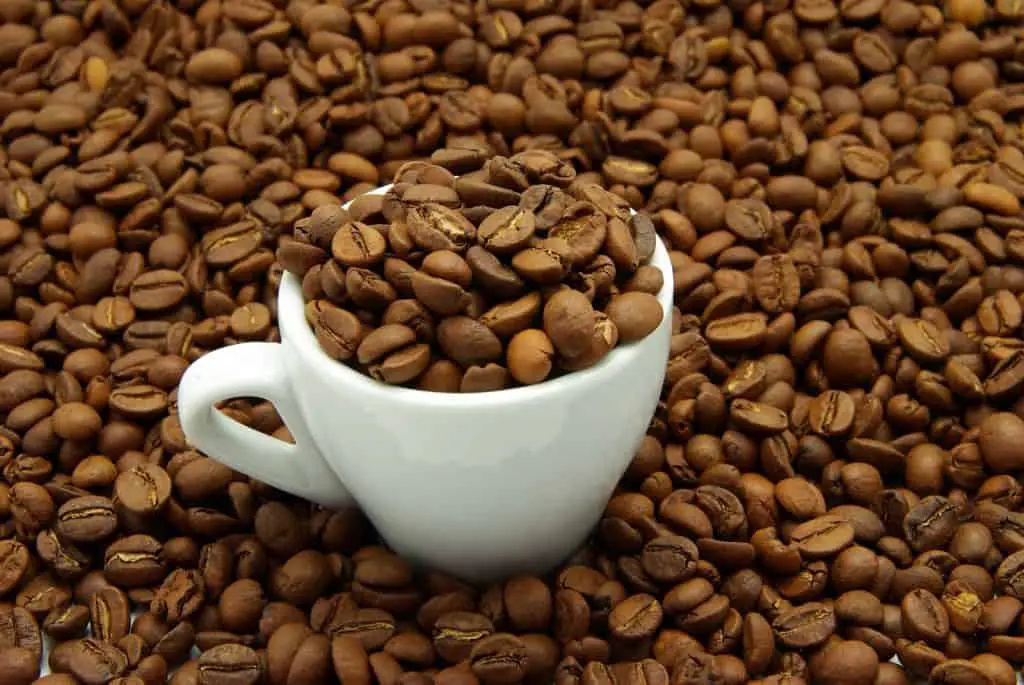Making coffee yourself guarantees a much better tasting cup. However, if you have a bag of whole coffee beans, you might ask yourself “how many coffee beans are in a cup of coffee“?

Today, I’ll present you with a complete answer that’ll provide you with everything you need to know regarding this aspect. So without further ado, let’s dive in!
How Many Coffee Beans Is Equivalent to a Cup of Coffee?
Before answering this question, you should know that coffee beans come in different criteria that can affect their density and overall weight. As a result, not all coffee beans are created equal.
According to a lot of variables, coffee beans can have different ratios of internal ingredients. Also, it can have different levels of moisture and more. Also, people enjoy different kinds of coffee ranging from mild to strong and bitter ones.
So, the exact number of coffee beans in a single cup depends on a lot of aspects. But more on that later.
How Many Coffee Beans per Cup of Coffee?
For the sake of argument, let’s consider the most average cup of coffee. Ideally, a cup of coffee has about two tablespoons of coffee grounds per 6 ounces cup. This makes it easy to measure if you need to measure coffee without a scale. This translates to about 7 to 10 grams of coffee grounds per cup. The ‘golden ratio’ is considered to be somewhere between 1:15 to 1:18 parts of coffee to water. In other words, you need between 15 and 18 times the amount of water compared to the amount of ground coffee to end up within the golden coffee to water ratio for brewing coffee at home.
As a rule of thumb, 10 grams of coffee grounds come from about 76 coffee beans in total. In other words, every coffee bean produces an average of ⅛ grams of final ground coffee that ends up in your cup.
Tracking the Journey of Coffee Beans
To understand how one bean ends up being ⅛ grams of ground coffee, we need to have a quick look at the journey coffee beans take until they reach your cup.
Coffee beans are the result of baking the seeds from two popular coffee plants. These ones are Coffea Arabica and Coffea Canephora. These plants produce evergreen shrubs with coffee berries.
Inside each berry, there are two coffee seeds, which later become the coffee beans we know after roasting. This means that you need about 38 coffee berries to make a cup of java.
The roasting process occurs at a high temperature that reaches between 355°F and 400°F. During this process, the starches inside the seeds are broken down and caramelized, losing a lot of moisture.
The result is a dark-colored bean that’s lighter in weight. Generally, the final roasted coffee bean usually weighs about 0.1325 grams, which is where the “75 to 76 beans per cup” rule comes from.
Does the Type of Beans Make a Difference?
There are multiple types of beans on the market. However, all these types come from two main types of coffee plants. These are Coffea Arabica and Coffea Robusta.
There are two other types of coffee beans, which are Coffee Liberica and Coffee Excelsa. However, they’re far less common than the first two – Does Coffee Have Calories? How many Calories are in Black Coffee?.
Coffee Arabica
Coffea Arabica is the first type of coffee plant to be systematically cultivated. Currently, Coffee Arabica is estimated to share with between 60 and 75% of the world’s annual production of coffee.
Many people refer to them as the mountain coffee because they’re grown in a higher altitude with constant rain and steady shades. Their trees are usually about 6-feet tall.
Due to the harsh conditions, they’re grown at, Arabica seeds contain more fats and nutrients reserves. That’s why they have a much richer shade of flavors than other kinds of coffee beans.
This makes arabica beans grow larger in size as well. As a result, they retain more of their weight after roasting.
Coffee Robusta
Coffee Robusta comes from the plant Coffea Canephora. It’s the second most popular type of coffee beans after Coffee Arabica.
It contains almost double the amount of caffeine and antioxidants when compared to Arabica’s beans. In fact, most people drink Robusta coffee for its high caffeine content rather than its taste or the quality of its coffee brews.
It grows at a much lower altitude. So, they’re relatively sturdier coffee beans with lower acidity and more bitterness than the Coffea Arabica. The more forgiving environment doesn’t force Robusta beans to grow large in size, which is why they’re smaller than Arabica beans after roasting.
Ideally, you need a bit more whole beans of Robusta coffee per your cup. However, the difference between the two isn’t that significant after all.

Does the Level of Roasting Impact the Number of Beans you Need for a Cup?
As you already know, the coffee beans we have are the final product after roasting the fresh seeds. Of course, this process has a huge impact on the number of beans you need for a cup.
When they’re just harvested, these coffee berries are red in color and are round-shaped. The coffee seeds inside are green and smaller in size. At this stage, these seeds weigh about 0.17 to 0.20 grams on average.
After fermentation and drying, the seeds are ready for the roasting process. During this process, coffee sets are put in a giant drum or container inside an oven.
This drum keeps moving to protect the coffee seeds from getting burnt. However, the continuous motion also encourages the beans to lose more moisture through the evaporation process.
Coffee beans are available in different roasting levels. These levels range from light to medium, medium-dark, and dark. The longer you leave the beans inside, the darker in color and lighter in weight they get.
From that, you can conclude that a dark-roasted coffee bean should be much lighter in weight. Therefore, you’ll need more dark beans in your cup when compared to light-roasted beans.
What Impact Does the Brewing Method Make?
Another aspect that might have an effect on the number of coffee beans in your cup is the brewing method itself.
As you know, not all brewing methods use the same amount of coffee beans. Also, some brewing methods require specific brewing time or different levels of roast. As a result, some of these brewing methods might be more wasteful than the others.
For example, you can compare the pour-over (drip) method with a French Press method. You’ll notice that to make equal cups of coffee with the same level of taste, you need to use more coffee beans. Brewing with a french press will require more coffee grounds that are also more coarsely ground compared to a drip coffee maker (Which is better percolator or drip coffee?) or when brewing pour-over coffee.
In addition to the brewing method, the brewing tool might also have an impact on the strength of the coffee. For example, in the pour-over method, the filter shape influences the amount of coffee extraction that happens.
For example, a cone-shaped filter might use fewer beans than a basket-shaped one, as it extracts more coffee per bean. All these reasons make some methods like French Press more wasteful or less efficient than using a drip coffee maker or brewing a cup of pour-over coffee.
Does the Grind Make a Difference?
Based on the previous example, it’s obvious that the grind of your coffee can make a huge difference.
If you try to compare the two methods by keeping all the other aspects equal, you’ll only change the grind size.
In the French Press method, you need to pass the coffee through a plunger with a filter. However, you need to make sure that your coffee is coarse enough to not pass through the filter – Are unbleached coffee filters better?
A coarse grind means that coffee grounds have less total surface area to come in contact with hot water. As a result, less coffee is exacted from the grounds. On the other hand, drip methods utilize a much finer grind of coffee. This translates to a much larger surface area for coffee brewing.
In other words, if you want to have fewer coffee beans while making your coffee, you need to grind the beans as fine as possible. However, you should keep in mind that finer grinds tend to pass through coffee filters easier – Blade vs burr coffee grinder – Which one to use!
Does a Small Cup of Espresso Require the Same Amount of Beans as a Cup of Coffee?
The short answer is yes.
Surprisingly, a shot of espresso typically has the same amount of beans present in a regular cup of coffee. Similar to a cup of java, a single shot has about 7 to 10 grams of ground coffee.
However, espresso shots are prepared by passing finely-grinded coffee beans through high pressure, which results in a much more concentrated espresso shot.
The confusion might come from the smaller serving size of an espresso shot, which is one ounce compared to 6 ounces of water in regular dripped or French Press coffee. However, this is only less water added to the same amount of coffee. The coffee to water ratio is different but the amount of coffee stays the same.
How Many Grams of Coffee Are in a Cup?
The amount of grams of coffee depends on the brewing method you’re following. Ideally, the standard drip-style coffee requires about 7 to 10 grams of coffee per cup. Other brewing methods have different amounts and how much coffee is needed per cup depends on the way you brew.
How Many Cups of Coffee Can you Make With One Pound of Coffee Beans?
A single pound of coffee beans is about 454 grams. Since one bean is about 0.1325 grams, this means that a single pound has about 3426 coffee beans.
As you already know, you need about 75 to 76 beans to prepare a cup of Joe. By doing the math, you can conclude that a single pound of coffee beans is enough to make 45 cups of standard cups of coffee.
How much coffee you need may increase or decrease based on all the previous aspects, such as the grind size, the type of beans, and the degree of roasting.
Final Thoughts
There are many aspects when it comes to how many coffee beans are in a cup and you measure coffee the right way. Some of them are more crucial than others.
For example, the type of bean and the brewing method doesn’t have as big of an impact as the size of the grind. Also, different roasting levels vary significantly in the final weight. With that said, you now have a clear answer on how many coffee beans are in a cup of coffee.

